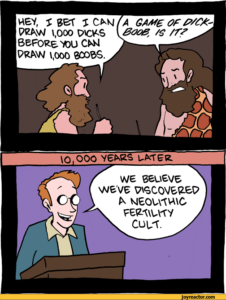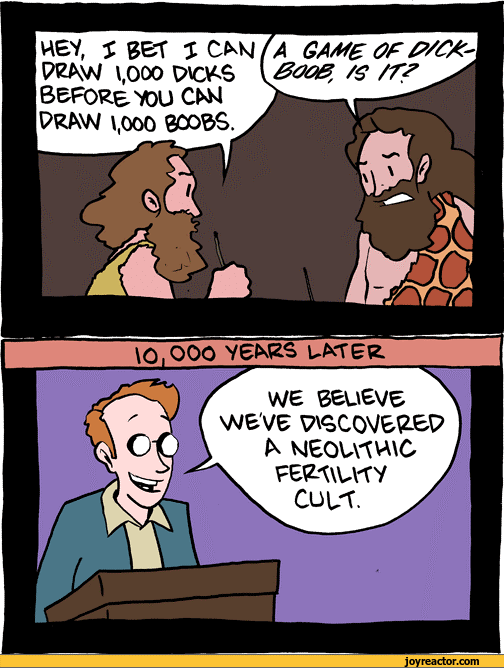A Responses to “Why do we believe? Evolution, Primates, and the Human Niche”
by Tenzan Eaghll
A couple years ago I stumbled across a cartoon in my Facebook feed. It details two images on top of one another: The first image is of two ‘cavemen‘ who randomly decide to draw a bunch of dicks and boobs on a cave wall. The first caveman says, “hey, I bet I can draw 1,000 dicks before you can draw 1,000 boobs,” and the other caveman response, “A game of dick-boob, is it?” The second image has a tag-line that reads, “10,000 years later,” and shows a modern academic in front of a podium giving a presentation on these cavemen drawings. The academic states confidently, “we believe we’ve discovered a neolithic fertility cult” This comic sums up my view of Agustin Fuentes’ evolutionary theory of religion.

Like the professor in this comic, Fuentes superimposes a whole host of modern assumptions about “belief” and “religion” upon evolutionary biology and ancient archaeological records. In his Gifford lectures series and his RSP podcast, Fuentes draws together an immense amount of evidence from bones, stones, biologies and ecologies to piece together an evolutionary theory of religion that stretches all the way back to the dawn of the genus homo. He tries to trace how the human lineage emerged over the past two million years and eventually developed distinctive characteristics and capacities that gave rise to belief, religious experience, and religion as we know it. The problem is, he never really finds any evidence for religion, he just posits a universal, transcultural, and quite frankly, vague theory about how religious experience is the distinctive trait that separates humans from all other species on the planet.
Now, to be clear, I should state at the outset that I don’t want to take issue with the scientific data Fuentes’ lays out in his Gifford lectures or his RSP podcast. What I take issue with is the way he ties all this data together in a grand theory of religion that ‘begs the question’ about the distinctive existence of religious experience. In fact, what is most frustrating about Fuentes lectures and podcast is that he uses his extensive training in biological anthropology to support his parochial ideas about religion, even when there is no evidential link between the former and the latter. Fuentes’ evolutionary theory of religion reminds me of those put forth by 19th century anthropologists of religion like E.B. Tylor or James George Frazer, because he is content to string together a wide array of data to support his theory, even when there are no clear causative links. Fuentes repeatedly assumes causation between different data sets that are barely even correlative, and assumes meaning and signification from records that may be arbitrary or even meaningless aspects of human evolution.
Moreover, the theory that Fuentes puts forth is reminiscent of some of the most essentialist explanations of religion ever developed. What Fuentes’ offers is no less than a vision of humankind as homo religiosus―of humankind as innately and distinctively religious. Of course, Fuentes’ never uses the term homo religiosus―perhaps he is aware of how outdated this would sound―but he argues that the capacity for religion is inherent in the human species at a universal and transcultural level. Quite boldly, he argues that religious experience of the transcendent is a natural outgrowth of the biological and cultural capacities that developed over the last several million years of human evolution, and that this capacity is distinctive enough to provide evidence for something called the “religious” that we can isolate from other aspects of human culture, such as politics, economics, art, etc.
In order to be as charitable as possible to Fuentes’ evolutionary theory of religion, let me summarize his arguments in three interconnected points. (Note: these points and quotations are extracts from both his Gifford Lectures and the RSP podcast):
1.What characterizes the human species is an “umwelt”—which he also calls the human niche. Fuentes borrows the concept of the umwelt from Jakob von Uexküll (1864-1944), for whom it meant the biological and environmental foundations for signification and communication in the human and non-human animal (Sebeok 1976, x). However, Fuentes places extra emphasis on the human capacity for “belief” and “transcendent experience” as key components of the human umwelt, and in doing so draws out a very Christian element from this old notion of the umwelt. As he writes in one slide for the Gifford Lectures, “transcendent experiences” are “a central process of the human niche.” Although he never provides a specific definition of what he means by the transcendent, in one of the question and answer periods to his Gifford Lectures series he cites Immanuel Kant’s distinction between the noumenon and the phenomenon to explain what he means by the term. For Kant, of course, the “nuomenon” is an intellectual conception of a thing that is not known through sense perceptions. (Interestingly, this reliance upon Kant to explain the tricky parts of his theory is something Fuentes also borrows from von Uexküll, whose work was hyper-Kantian and mixed biological evidence and theory with the Kantian idea that all reality is subjective appearance).
2.The capacity for belief is a central component of this niche. In the Gifford Lectures, Fuentes describes belief as “a commitment that humans evolved to make.” In his most general use of the term, Fuentes claims that belief can and has been used for shaping our world not just in terms of religion, but economies, political systems, war, devotion, desire, and even hatred. However, in terms of religion, he links belief to the notion of faith, the human openness to revelation (however that might be experienced), and as I have pointed out, the experience of the transcendent. In the RSP podcast Fuentes provides this cogent definition of belief:
“[B]elief is a human capacity that has emerged over our evolutionary histories, to take our cognitive, social, communal, historical, and ecological processes, to include what we can call ‘detached representational off-line thinking’―the imaginary―to combine those, such that the imaginary―even the transcendent―can become part of the physical, the perceptual, and the material in our niche.”
Sometimes when Fuentes refers to belief he seems to suggest that it is an act of human agency, and at other times that belief systems act upon humans and human communities. As he states in the Gifford Lecture series, “Belief and belief systems themselves can act as elements in the construction and modification of the structural parameters of the human niche, materially and perceptually.” In terms of priority, however, he seems to want to suggest that beliefs first emerged in human agency and then extended to pervade the cultural systems of early humanoids. (In relation to religious studies theory, this is interesting because it bears some resemblance to E.B. Tylor’s theory for the origins of religious belief in the “noble savage.” Of course, Fuentes’ theory would be far more complex than Tyor’s because of his emphasis on the biological and ecological elements of the human niche that give rise to belief, but there would still be similarities.)
3.This biological capacity for belief that developed evolutionarily is where the capacity for the religious emerges from. Citing the work of Roy Rappaport and Robert Bellah to bolster his claims, Fuentes’ argues that the capacity for religion emerged in conjunction with our capacity for belief and is elemental for all human evolution. Again, he explicitly links this capacity for belief with the experience of the transcendent. As he states in lecture five of the Gifford Lectures:
“By religious I mean, the use of one’s capacity for belief in the context of becoming, with particular perceptual and experiential and agential practices, involving the transcendent, that act to create powerful, persuasive, and long lasting moods and motivations, and that may be, but are not necessarily, tied to specific formal doctrines, practices, texts, or institutions.”
With this definition Fuentes draws a distinction between “religious” and “religion.” He explicitly cites both Clifford Geertz’ and Emile Durkheim’s definition of religion, while also keeping them separate. If I understand him correctly, Fuentes wants to use Geertz’ definition of religion to understand the capacity to be religious that he claims became part of the human niche between three and four hundred thousand years ago, and he wants to use Durkheim’s theory of religion to understand the specific history of religions that he claims began around eight to six thousand years ago.
Fuentes’ evolutionary theory of religion is built upon these three points, and, I would suggest, amounts to a definition of humankind as homo religiosus. Quite simply, he claims that the capacity for religious experience is inherent in our species and is part of what makes us distinctive from other animals, and this fits the broad definition of homo religiosus that gained popularity in the 19th Century. As Fuentes states in the latter half of the RSP podcast:
“I argue that it is inherent, as an outcome and a part of the process of our capacity for belief, that humans have the capacity to be religious.”
Quite frustratingly, Fuentes’ backs up this claim with an appeal to common sense that is bound to make any critical theorist of religion face-palm: “I think anyone worth their salt looking at our history, says ‘humans have been and are religious.”
In sum, for Fuentes, there is something unique about religious experience that unites humanity as a species and provides a fundamental unity for all humankind that is much more essential to being human than anything simply biological. Though his position is far less theological than earlier theorists who have argued that humanity is inherently religious, it is similar to theorists like Friedrich Schleiermacher, Rudolf Otto, and Mircea Eliade, because Fuentes sees religion as an outgrowth of a distinctive experience that can be isolated from other types of phenomena. For Schleiermacher this distinctive experience is a “feeling of absolute dependence,” for Otto it is the “numinous,” for Eliade it is the “Sacred,” and for Fuentes it appears to be the “transcendent” (defined in Kantian terms).
Theoretically, what is most frustrating about Fuentes’ claims is that he does not seem to have read any critical scholarship that challenges such broad sweeping evolutionary theories of religion. His emphasis on religious experience as a universal and transcultural phenomenon shows a complete ignorance, for example, of Talal Asad’s critique of Clifford Geertz’s anthropological definition of religion; not to mention all of the recent genealogical work tracing the very modern invention of the academic category of religion. Moreover, Fuentes seems unaware of the fact that the distinction between the “religious” (as a distinctive experience or capacity) and “religion” (as an institutional form), is a trope that was first used by theologians in early modern Europe, and was later systematized into the idea of “natural religion” in the work of philosophers like Kant. As Talal Asad notes, “the idea of Natural Religion was a crucial step in the formation of the modern concept of religious belief, experience, and practice, and that it was an idea developed in response to problems specific to Christian theology at a particular historical juncture” (Asad 1993, 122). Fuentes wants to extract this Christian, Eurocentric, and very modern notion of subjective religious experience from its specific discursive and colonial history―not to mention the Kantian distinction between noumenon and phenomenon and the notion of the transcendent―and apply it transhistorically and transculturally to explain the emergence of modern religious forms. At the end of the day―even with all the evidence from bones, stones, biologies and ecologies―it all just ends up sounding Christian, all too Christian.
Another assumption that Fuentes embraces, which has also been subject to considerable scholarly debate that he ignores, is the priority of belief over ritual in the creation of human meaning. As noted above, Fuentes seems to position belief as a prior act in the creation of human meaning, ritual, and ultimately religion, yet this flies in the face of much critical research on the subject, and again places his theory of religion in line with 19th and early 20th Century theorists. For instance, in 1975 Indologist Frits Staal argued rather persuasively that rituals―and religion―are meaningless. In contrast to Fuentes, who seems to think that everything means something and can thus be used to gerrymander his theory of religion, Staal argued that ancient Hindu sacrifice rituals are a form of praxis without any intent, function, or goal, and are therefore meaningless. Moreover, Staal connects his argument with the origin of language in general, challenging any meaning-based reading of human history. Staal concludes his famous essay with the following remarks that may be covertly addressed to theorists like Fuentes: “There must be readers who are shocked, angry or depressed at the thought that ritual (not to mention religion and even language) is not only complex but also meaningless. I am not a bit sad about it. I prefer a thing, like a person, to be itself, and not refer to something or somebody else. For all we know life itself may be meaningless” (Staal 1979, 22).
In the first of his Gifford Lectures Fuentes tells an anecdote to explain his underlying methodology and motivation. In this anecdote he refers back to a critical review he received almost two decades ago in relation to one of his manuscripts. The reviewer said, “Fuentes is not a philosopher, nor should he try to be one.” Fuentes references this harsh critique of his early work to assert that he is indeed not a philosopher, but a scholar, and one who believes in the value of interdisciplinary work. At the risk of opening old wounds, I don’t want to add to this criticism of Fuentes a similar statement regarding religious studies, nor to take away his desire for interdisciplinary work, but I would suggest that if he wants to continue to write on the subject of religion he should make a more earnest attempt to engage with critical scholarship on the subject.
References
Sebeok, Thomas A (1976). “Foreword.” Contributions to the Doctrine of Signs. Lisse: Peter de Rider Press.
Asad, Talal (1993). “The Construction of Religion as an Anthropological Category.” Genealogies of Religion: Discipline and Reasons of Power in Christianity and Islam. Baltimore: John Hopkins University Press.
Staal, Frits (1979). “The Meaninglessness of Ritual.” Numen 26: 2–22.



